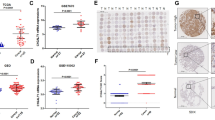Abstract
Hepl, first described in 2008, is the fourth member of the Crk-associated substrate (CAS) family and is specifically expressed in the lung. Compared to other CAS proteins, Hepl has a varying effect on cell migration in different cell types. We speculated that Hepl may play a role in lung cancer invasion and metastasis. We quantified the expression and subcellular localization of Hepl in 143 non-small cell lung cancer (NSCLC) tissues, adjacent noncancerous tissues, and eight lung cancer cell lines using Western blotting, immunohistochemistry, and immunofluorescent staining. Expression of Hepl was correlated with the clinicopathological features of NSCLC. Hepl was overexpressed in 72.3 % (103/143) of the NSCLC tissues, compared to the adjacent noncancerous lung tissues (P = 0.022). Overexpression of Hepl was associated with lymph node metastasis and high TNM stage (P = 0.005 and P = 0.045, respectively). Kaplan–Meier survival curves and the log-rank test indicated that overexpression of Hepl correlated with poorer overall survival in NSCLC (P < 0.001), and Cox regression analysis demonstrated that overexpression of Hepl was an independent prognostic factor in NSCLC. Furthermore, cytoplasmic accumulation of Hepl was observed in a high metastatic potential lung cancer cell lines (H1299 and BE1), but not in low metastatic potential cell lines (LTE and A549). This study reveals that Hepl is overexpressed in the nucleus and aberrantly accumulates in the cytoplasm of NSCLC cells, and indicates that Hepl may play a role in the progression of lung cancer, including lymph node metastasis and TNM stage. Additionally, Hepl may be a useful prognostic factor in lung cancer.




Similar content being viewed by others
References
Tikhmyanova N, Little JL, Golemis EA. CAS proteins in normal and pathological cell growth control. Cell Mol Life Sci. 2010;67:1025–48.
Brabek J, Constancio SS, Siesser PF, Shin NY, Pozzi A, Hanks SK. Crk-associated substrate tyrosine phosphorylation sites are critical for invasion and metastasis of SRC-transformed cells. Mol Cancer Res. 2005;3:307–15.
O'Neill GM, Seo S, Serebriiskii IG, Lessin SR, Golemis EA. A new central scaffold for metastasis: parsing HEF1/Cas-L/NEDD9. Cancer Res. 2007;67:8975–9.
Hisakawa N, Tanaka H, Hosono O, Nishijima R, Ohashi Y, Saito S, et al. Aberrant responsiveness to RANTES in synovial fluid T cells from patients with rheumatoid arthritis. J Rheumatol. 2002;29:1124–34.
Dutt P, Wang JF, Groopman JE. Stromal cell-derived factor-1 alpha and stem cell factor/kit ligand share signaling pathways in hemopoietic progenitors: a potential mechanism for cooperative induction of chemotaxis. J Immunol. 1998;161:3652–8.
Donlin LT, Danzl NM, Wanjalla C, Alexandropoulos K. Deficiency in expression of the signaling protein Sin/Efs leads to T-lymphocyte activation and mucosal inflammation. Mol Cell Biol. 2005;25:11035–46.
Law SF, O'Neill GM, Fashena SJ, Einarson MB, Golemis EA. The docking protein HEF1 is an apoptotic mediator at focal adhesion sites. Mol Cell Biol. 2000;20:5184–95.
Kim W, Kook S, Kim DJ, Teodorof C, Song WK. The 31-kDa caspase-generated cleavage product of p130cas functions as a transcriptional repressor of E2A in apoptotic cells. J Biol Chem. 2004;279:8333–42.
Kim W, Seok Kang Y, Soo Kim J, Shin NY, Hanks SK, Song WK. The integrin-coupled signaling adaptor p130Cas suppresses Smad3 function in transforming growth factor-beta signaling. Mol Biol Cell. 2008;19:2135–46.
Hakak Y, Martin GS. Cas mediates transcriptional activation of the serum response element by Src. Mol Cell Biol. 1999;19:6953–62.
Honda H, Oda H, Nakamoto T, Honda Z, Sakai R, Suzuki T, et al. Cardiovascular anomaly, impaired actin bundling and resistance to Src-induced transformation in mice lacking p130Cas. Nat Genet. 1998;19:361–5.
Seo S, Asai T, Saito T, Suzuki T, Morishita Y, Nakamoto T, et al. Crk-associated substrate lymphocyte type is required for lymphocyte trafficking and marginal zone B cell maintenance. J Immunol. 2005;175:3492–501.
Cabodi S, del Pilar C-LM, Di Stefano P, Defilippi P. Integrin signalling adaptors: not only figurants in the cancer story. Nat Rev Cancer. 2010;10:858–70.
Klemke RL, Leng J, Molander R, Brooks PC, Vuori K, Cheresh DA. CAS/Crk coupling serves as a “molecular switch” for induction of cell migration. J Cell Biol. 1998;140:961–72.
Defilippi P, Di Stefano P, Cabodi S. p130Cas: a versatile scaffold in signaling networks. Trends Cell Biol. 2006;16:257–63.
Tikhmyanova N, Golemis EA. NEDD9 and BCAR1 negatively regulate E-cadherin membrane localization, and promote E-cadherin degradation. PLoS One. 2011;6:e22102.
Singh MK, Dadke D, Nicolas E, Serebriiskii IG, Apostolou S, Canutescu A, et al. A novel Cas family member, HEPL, regulates FAK and cell spreading. Mol Biol Cell. 2008;19:1627–36.
Law SF, Estojak J, Wang B, Mysliwiec T, Kruh G, Golemis EA. Human enhancer of filamentation 1, a novel p130cas-like docking protein, associates with focal adhesion kinase and induces pseudohyphal growth in Saccharomyces cerevisiae. Mol Cell Biol. 1996;16:3327–37.
Nakamoto T, Sakai R, Ozawa K, Yazaki Y, Hirai H. Direct binding of C-terminal region of p130Cas to SH2 and SH3 domains of Src kinase. J Biol Chem. 1996;271:8959–65.
Alexandropoulos K, Baltimore D. Coordinate activation of c-Src by SH3- and SH2-binding sites on a novel p130Cas-related protein, Sin. Genes Dev. 1996;10:1341–55.
Travis WD, Brambilla E, Müller-Hermelink HK, Harris CC. Pathology and Genetics: tumours of the lung, pleura, thymus and heart. Lyon: IARC; 2004.
Goldstraw P. Updated staging system for lung cancer. Surg Oncol Clin N Am. 2011;20:655–66.
Bradford MM. A rapid and sensitive method for the quantitation of microgram quantities of protein utilizing the principle of protein-dye binding. Anal Biochem. 1976;72:248–54.
Natarajan M, Stewart JE, Golemis EA, Pugacheva EN, Alexandropoulos K, Cox BD, et al. HEF1 is a necessary and specific downstream effector of FAK that promotes the migration of glioblastoma cells. Oncogene. 2006;25:1721–32.
Acknowledgments
This work was supported by grants from the National Natural Science Foundation of China (No. 81000942 to Yuan Miao and No. 30900562 to Yang Liu).
Conflict of interest
None
Author information
Authors and Affiliations
Corresponding author
Rights and permissions
About this article
Cite this article
Miao, Y., Wang, L., Liu, Y. et al. Overexpression and cytoplasmic accumulation of Hepl is associated with clinicopathological parameters and poor prognosis in non-small cell lung cancer. Tumor Biol. 34, 107–114 (2013). https://doi.org/10.1007/s13277-012-0517-x
Received:
Accepted:
Published:
Issue Date:
DOI: https://doi.org/10.1007/s13277-012-0517-x



